WINTER MOTORCYCLE RIDING TIPS
For some riders, biking is a seasonal pleasure restricted to sunny weather and summer track days, but for others it’s a year-round labour of love. With our winters becoming a lot more harsh with snow, ice, rain and foggy weather, it’s extremely important that you remain as safe as possible on two wheels. So if you’re committed to staying on two wheels through the cold winter months, how best to cope with the greasy roads and sub-zero conditions?
With a predicted La Niña event looming, here are Devitt’s top 10 tips to not just survive but actually thrive when the temperature plummets. And don’t forget, if it’s all too much then you can always opt for a different mode of transport – safety first!
Get into right winter riding gear
The meat and potatoes of your winter riding gear should be a decent jacket and pair of trousers, supplemented with thermal tops and leggings on really cold days. Keep your body’s core as warm as possible and your less well-protected extremities have a fighting chance of keeping the cold at bay for longer.
Credit: Devitt
There’s a huge range of textile outfits available, but ensuring a proper fit – not too tight, not too loose, arm and leg length just right when you’re sitting on the bike – is just as important as the water-, weather- and crash-protection qualities.
High-cut bib and brace trousers offer the best defence against the cold by keeping your torso better insulated and helping prevent draughts around your waist. Throw in a heated vest and you could end up being warmer on the bike than off it.
If you prefer the security of leather over the superior weather protection of textiles, then an unlined one-piece oversuit can provide a decent degree of insulation. They can be a pain to get on and they’re hardly the last word in style but you won’t get any draughts around your waist and nothing does a better job of keeping the rain out.
Motorbike winter prep
Is your bike ready for winter? It’s going to take a hammering from the elements so give it a good clean and treat it to a corrosion-inhibiting spray, such as ACF-50 or Scottoiler’s FS 365.
Make sure the levers and controls are properly adjusted and lubricated, particularly the throttle cable and twistgrip. Most importantly, are your tyres up to the job? They need to be suitable for cold- and wet-weather use, with a broad tread pattern and a high silica content. Semi-slick summer track day rubber won’t do.
First things first
Credit: Flickr
If you have to touch anything cold to get your bike ready to go on a cold morning – a lock and chain or a garage door handle, for example – do it wearing gloves. If your riding gloves are too bulky for fiddling with keys and padlocks, keep a thinner pair handy. It might mean a few seconds more faffing about, but touching cold metal with bare hands will chill your fingers in seconds. If you start your journey with cold hands, they’re only going to get colder, so do everything you can to keep the frostbite at bay.
Invest in heated grips or gloves
Painfully cold, numb fingers are the bane of the winter motorcyclist. Heated grips or heated gloves can be a godsend, and once you’ve tried them you’re unlikely ever to look back. Some bike manufacturers fit them as standard or offer them as accessories, but if you’re fitting aftermarket items yourself, make sure they’re properly wired in so you don’t kill your battery or set fire to something.
If you don’t go down the electrical route, buy the best winter gloves you can afford. Make sure they’re not so bulky that you can’t operate the controls properly, and ensure you can get a good seal around your jacket’s cuffs.
Failing that, you could throw fashion to the wind and fit handlebar muffs (although off-road-style hand guards look quite cool and keep the worst of the wind chill off).
Keep your toes warm too!
Your feet are the forgotten heroes of winter riding, left quite literally out in the cold but with important jobs to do. Winter boots and socks will keep your toes cosy up to a point and heated insoles are available (remember to unplug them before you get off, though), but if you cram too much extra kit into your boots along with your feet, you could end up restricting both movement and blood flow, which will defeat the object.
You can delay the onset of permafrost in your socks by riding as much as possible with your toes resting on the footpeg. Ride with the arch of your foot on the peg and your toes tend to stick out at an angle into the windblast, which isn’t ideal!
Neck warmers are a must have!
Make sure the gaps around your neck, cuffs, waist and ankles are properly sealed. Leaky cuffs can direct cold air and rain up your sleeves or down into your gloves. Some combinations of jacket and glove seal best with the jacket sleeve done up over the glove rather than tucked under it, so experiment to find out which works best for you.
Neck warmers are essential, not only for keeping your exposed neck warm but also for ensuring a good seal around your jacket collar and under your helmet. There are dozens on the market, so find one that bests suits you. Just make sure it doesn’t restrict your head movement or block the airflow under your chin so much that it causes visor misting (see below).
Visor maintenance is a must
Visor misting can be a real problem in winter, so visor maintenance needs to be a daily ritual. There are sprays and wipes on the market to help prevent misting but you’ll need to apply them regularly. Anti-misting inserts such as FogCity and Pinlock work very well provided they’re properly fitted. They can also be compromised if the inside of the visor gets wet, so if it’s raining you need to keep your visor closed at all times – which can cause problems if you wear glasses under your helmet.
Stay smooth
Smoothness is key on cold, greasy roads. In low-grip conditions jerky, nervous inputs will be mirrored in your bike’s reactions, which in turn are likely to make you feel even less secure and confident. It’s a downward spiral.
Watch the throttle
If your bike has switchable traction control, you can sit back and let your ECU do the hard work on slippery roads. For the rest of us, good throttle control is vital.
Smoothness is crucial. Snap the throttle open and you’re likely to break traction; instead, wind it on progressively, with your throttle position always matching engine revs. There should be a direct correlation between throttle position and engine response. On big bikes especially, don’t be tempted to crack the throttle wide and wait for the revs to catch up – if the wheel does start to spin it will continue to do so even as you’re rolling the throttle off. It might only be for a fraction of a second but that could be enough to put you on your ear.
While road salt prevents ice forming – at least to a point – it draws moisture out of the air and creates a slimy film even if no rain has fallen. Manhole covers, white lines and cat’s eyes become even more slippery than usual, so look well ahead to avoid them and don’t target fixate. If you can’t avoid something extra slippery, ride over it on a neutral or positive throttle; panic and snap the throttle shut and you’re more likely to lose the front end.
Freshly fallen snow can actually provide a modicum of grip (don’t try getting your knee down, though), but all bets are off once it’s compacted into ice. If you do find yourself riding on ice then don’t be tempted to ride with your feet dangling down to catch a slide. The chances are that you won’t be able to stop the bike going down and you’re risking breaking an ankle or two.
Modern ABS has done away with concerns about locking a wheel, but riders of pre-ABS bikes will have to be more circumspect. Again, smoothness – that word again – is everything and most crucial during the initial application of the brake. In fact, it begins with closing the throttle before the brake is applied, because even the sudden forward weight transfer of a snapped-shut throttle can unsettle the front on a slippery road. Once the weight has been transferred forward you can add more braking force – but only up to a point.
If it’s too much, leave the bike at home!
If the weather gets really arctic then sometimes the best option is to put the bike away, put the kettle on and put your feet up until the spring – and we won’t think any worse of you for doing that.

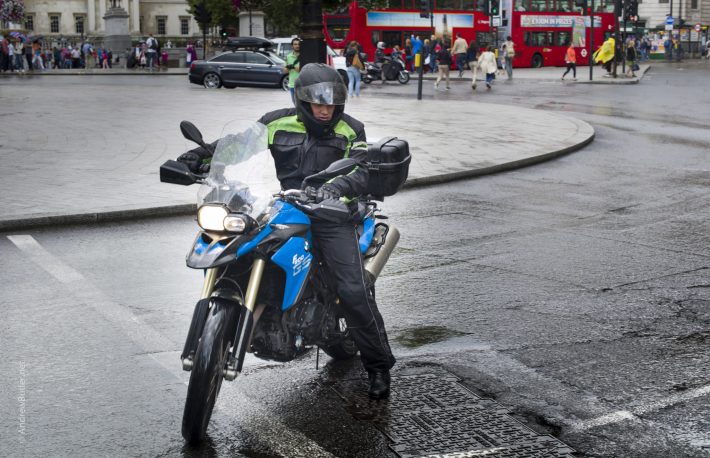
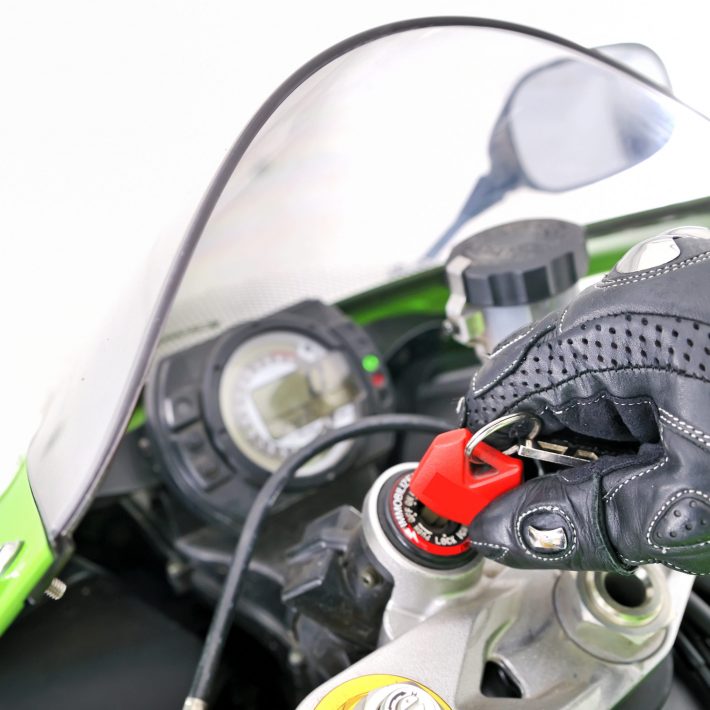
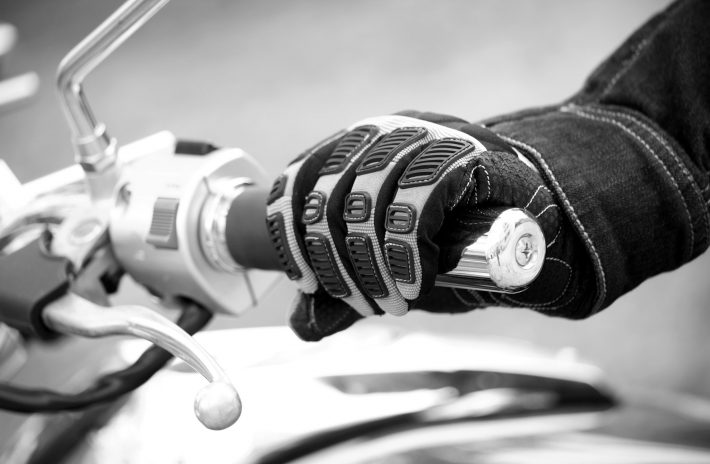
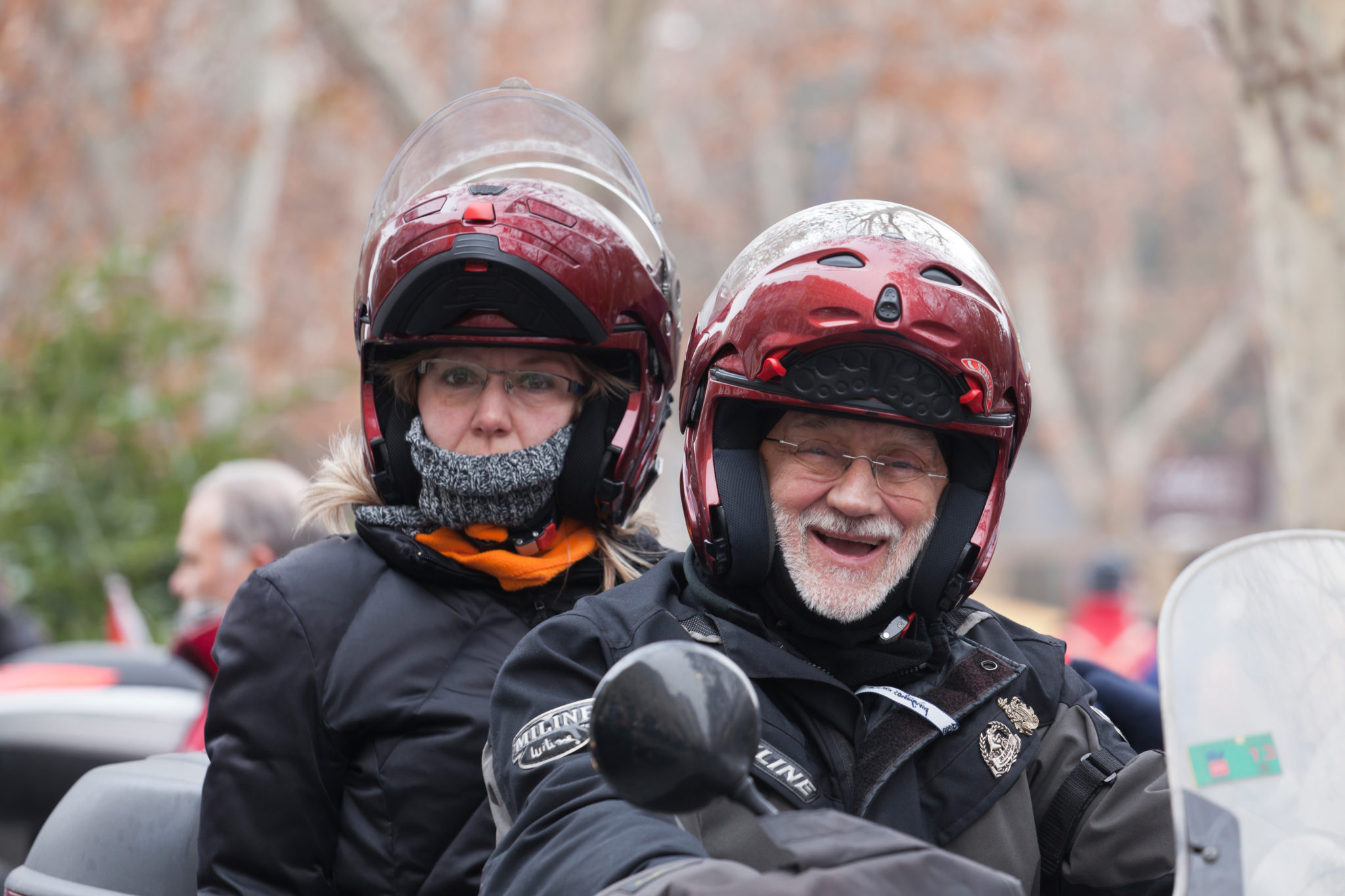
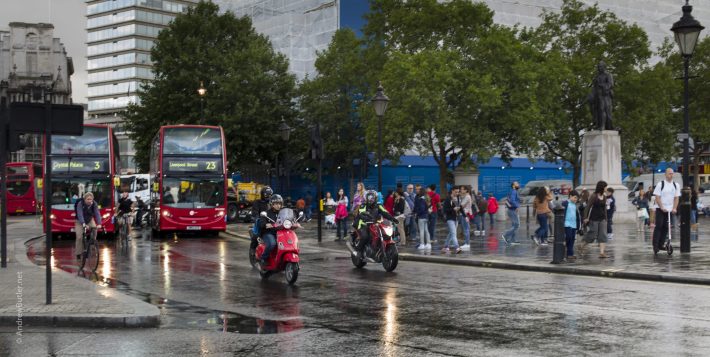
17 comments on “Top 10 Winter Riding Tips”
Although it’s still important at any time of the year, during the winter months this is critical…
Never approach any junction in the middle of a lane. Stay in the wheel tracks of other vehicles. The middle of the lane is going to be covered in a layer of greasy oil from vehicles waiting in traffic. Add a bit of dampness or rain to that surface, and it’s lethal under braking.
It’s all too natural to position yourself in the middle of a lane, and for the most that’s fine. But don’t do it any where that vehicles can congregate in traffic. Think, as you approach the junction. Position yourself in the strips of road ‘cleaned’ by others, and don’t leave braking to the last minute.
You will also find that there is less likelihood of your back tyre losing traction as you pull away, since you’ll be on a cleaner surface.
Ride safe!
Sorry I don’t agree….. What you have also to realise that the tyre tracks left by cars may not be the safest place either. Many roads over time, lose their grip availability by the wearing down of the roads surface. By what is called fretting . By the constant rubbing between the tyre and the road surface., Not only is grip ie. gravel lost but a layer of tyre rubber is left on that surface and that makes it dangerous. That means that two tracks wear down to have no gravel at all and all that is left is tarmac or bitumen, whatever you want to call it.
It may be out of date to warn riders about the dangers of the mid line or sump line as in many cases its the safest and driest part of the road and with plenty of grip that the other two lines don’t have. Grip well enough to ride upon and in the wet you can clearly see the tracks of the cars wheel tracks that are shiny and missing any gravel and therefore lacking grip whilst riding on them, braking and accelerating at junctions etc. becomes a problem especially when in the wet.
About oil spillage, that is very much a thing of the past when badly made cars were on the roads and many a motorcycle was considered to be an oil slick machine where you didn’t just top up the oil, you merely and regularly re filled the sump. Cars are much tighter now and if oil does spill into the road the fact that there is gravel on the sump line means that one will be very unlikely to suffer any consequences from it due to the ridges or peaks created by the gravel.,.
However oil and/or diesel on just bitumen is like riding on ice and should be avoided at all cost.
Watch out on roundabouts hgv’s and buses spill diesel if you see a rainbow affect on the road that’s diesel stay off it it’s worse that ice because it stays on your tyre’s one thing that’s always kept me safe is if it shines its slippery a little less throttle and easy on the brakes keep it smooth
Diesel was more of problem some years ago with the overfilling of HGV tanks and then the vehicles going round corners or bends etc. and the diesel spilling out of an overflow mechanism., Since then many newer vehicles have been fitted with a devise that stops the overfilling thus they wont lose diesel.
However some still do and its not just on bends and roundabouts its actually on the roads directly outside the petrol stations. As the vehicles pull out fast into the road it can cause such spillage. So beware when passing petrol stations at all times winter and summer alike.
I see no problem with riding in the sump line or of stopping at junctions as I do not see modern vehicles dropping oil from their sumps anymore. That did happen up to the 60s but with modern cars coming in from Japan etc. they manufacture sump seals better and so do not be afraid of the sump line.
Yes at times there is debris on them that has not been cleared by cars tyres but in the main they have more aggregate as its not worn down as are the two side lines that we are instructed to ride on, the tyre lines, positions 1 and 3 . They may at times be far worn and just have the bitumen left and no aggregate so they are by there nature old and well worn and slippy.
So much so that its like riding on wet white lines, They are slippy and when wet the safe braking distance will be somewhat further. So try to avoid those well worn areas that can be easily see cos when wet they actually shine. If accelerating away whilst on these well worn and slippy lines be careful as too much throttle can overload ones rear tyre grip on such a worn and slippy surface.
The sump line at those times provides far more useful grip.
Mark, I think there’s an element of living in the past, yes in the 70’s cars did leak oil in the middle of the lane.
Not nowadays, in fact there’s an argument that the central section is actually the grippiest, as it’s just not used by cars & lorries etc, and the two tyre tracks either side of the centre get worn and in some cases polished to a shine providing much less grip than the centre line.
For motorcyclists riding in towns, especially in the centre of your own lane increases your safety bubble with options to move away from other hazards left & right of you.
MartinR
That is what I said earlier. plus you will have noticed that when the road is wet and with low sun the tyre tracks that are well worn are also reflecting that sunlight up from the roads surface and into your eyes. There is little one can do about it except wear sunglasses. It is a danger so one has to slow down.
I have always, well since the 60’s placed a strip of electrical tape pref. black along the top and bottom of my visor and with the visor either up or down or slightly so it does stop sunlight from hitting the eyes directly and that can help when riding into low sun and possibly the lower strip can alleviate some light reflecting up from that shinning and reflective road surface,.
I always drop my tire pressure by just a couple of psi in the coldest weather to put a little more tread on the road and try not to over lean when turning into roads.
IN cold weather your tyre will lose some small amount of pressure normally so their is no justification for reducing them even more. Its an old trick used decades ago that really shouldn’t be practised today.
The loss of a couple of lbs in a tyre is not anything dangerous and one can ride as per normal but excessive reductions, anything over 2 lbs should not be ridden on as the stability of the bike can become compromised. .
The stability is more likely to be lost when riding round bends, corners and cornering as one is now on the sidewall and without sufficient pressure the sidewalls will be less rigid, by being so more pliable they will give more and get more out of shape so beware about lowering tyre pressures. One can end up distorting the tyre and a new one will be needed in less time due to wear out.
Winters now are nothing to what we had years ago. I remember coming home from RAF in Germany between Xmas 1962 and New Year. About 12″ (300 mm) snow all the way from Dover to my destination at Chester. All my goods loaded on the back of my BSA Shooting Star. After 15 hours I’d made it to Cannock.
One pieced of advice not given relates to the brightness of low sun and its dangers when riding in it. Even if you wear sunglasses and or have a darkened visor they still will allow a certain amount of bright sunlight to penetrate the eye and that’s when we get glare difficulties from.
The safest and easiest thing that you can do is to wear a peaked cap so as to protect your eyes from that direct sunlight, but we cant wear a peaked cap can we. So, and this has worked well for me since the 1960,’ is to place a strip or two of electrical tape pref. black in colour at the top and bottom of your helmets visor These strips can be used to eliminate any direct sunlight from entering your eyes. and it really works and does no damage to your visor at all.
Have you ever ben concerned whilst riding with your back to the sun and showing a long shadow in front of you. Well you should be. If you don’t realise that the low sun is behind you you will be put in danger by any driver heading towards you and wanting to turn right at a road junction and across your path or of any driver at any junction ahead of you and again waiting to turn in front of you. They all will if they are blinded by the sunlight in front of them. You may well be a double decker bus or HGV but if you are in front of low sun then most drivers won’t see you. So be aware of that hidden danger if you are showing and following your own shadow.
Good advice.
Also be aware of diesel spills whilst approaching, passing or leaving the exits to petrol stations. Such spills were a regular pain a few years ago but many tankers now have overspill devises fitted but there are still some older vehicles that don’t have it and if they overfill when filling in the first place and it spills when the vehicle is turning out of said petrol station. Sometime its not seen but can be smelled.
Here is a simple method that anyone can do whilst driving a car etc and stopped at a junction with difficulties seeing to their right towards you and towards the sunlight behind you.
Quite simply do this. First, instead of looking through a dirty or wet door window turn the window down about 1/2 to 2/3 rds. the way . Then turn the sun visor to its right. its designed to do just that and place that visor down and above the now open window.,
With that visor down and clear open space to see through ones eyes are now shielded from the direct sunlight, preventing it from entering the eye and so vision is immediately returned to normal and one can see everything that is approaching. Simples.
Why don’t drivers understand that looking at or towards the sun at nearside junctions as you are approaching with the sun behind you, is much easier and safer if they do just two simple things. Have you noticed just how the try to scan towards you but many are obviously not happy with what they can see.
First One is to open the car door window for a start. Air is cleaner than a dirty or wet window and thus there is no sunlight acting upon it. Then just turn ones sun visor to ones right and place it over that open window and that will shield ones eyes from the effects of direct sunlight,. Its that or open the window and wear a peaked cap that will do the same thing as the visor.
Turn yourself into a boy racer and wear a baseball or golfing cap. That visor swivels on its right hand side and its there to be moved as stated but drivers are lazy or have no clue. Many are clueless anyway.